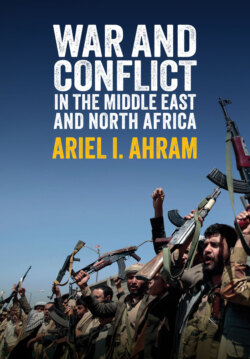Читать книгу War and Conflict in the Middle East and North Africa - Ariel I. Ahram - Страница 9
Which MENA?
ОглавлениеIn an influential critique of scholarship about the Eastern (i.e., Oriental) world, literary scholar Edward Said noted how “[f]rom the beginning of Western speculation about the Orient, the one thing the Orient could not do was to represent itself. Evidence of the Orient was credible only after it had passed through and been made firm by the refining fire of the Orientalist’s work.”10 Scholarship resorted to binary distinctions between the East and West, which explicitly and implicitly overlaid normative categories of normal versus exotic, free versus subordinate, “us” versus “them.” This cultural tendency reinforced the drive for political and economic domination.
Heeding this warning, it is important to stress that the terms “Middle East” and “MENA” are neither indigenous nor inevitable. Rather, they are exonyms, terms applied by foreigners to describe an area they found strange and distant. Understanding the origins of this terminology is important for grasping some of the biggest drivers of political development and conflict. British and American officials coined the term “Middle East” around the turn of the twentieth century. It roughly denoted the lands between the Mediterranean Sea and Indian Ocean, comprised of the Levant, Arabian Peninsula, Iran, and Central Asia. Middle East replaced the older term “Near East,” which was often used to describe Christian missionary activities in and around the Holy Land. Most of the Middle East was under the rule of the Ottoman and Iranian empires, two of the great Muslim empires of the early modern era. This was a space that European powers saw as a target for subordination. North Africa, at this time, was a different story. Morocco, Algeria, Tunisia, Libya, and Egypt were already being transformed into European colonies by the end of the 1800s. European powers thus treated this area, referred to as the Maghreb (“the west”) in Arabic, as a separate region. Only in the mid-twentieth century did the unwieldy conjunction “Middle East and North Africa” became common.11
In its most basic sense, then, the term “MENA” reflects an imperial outlook that the people of the region do not share. Those living in Rabat, Cairo, or Tehran do not naturally think of themselves as “east” of anything; their politics and their territories deserve center stage. Although today the terms “Middle East” and its adjuncts are common in regional discourse, other conceptual terminology is available.12 Indigenous terms like “Arab world” (al-‘alam al-‘arabi) or “Domain of Islam” (dar al-Islam) suggest different ideas about the origins of regional unity and shared regional destiny. Historian Nikki Keddie pointed out that the idea of “the Muslim world is too unwieldy a unit for most ordinary mortal scholars to deal with.”13 Nonetheless, she stressed, it must be remembered that this is the unit with which many inhabitants of the Middle East historically self-identified. Invocations of Islamic unity continue to the present day. On the other hand, when politicians or pundits in the region describe their country as “Western,” they are often asserting their superiority over otherwise “eastern” neighbors. Regional terminology comes laden with particular historical and normative connotations.14
For the purposes of this book, MENA stretches roughly from the Atlantic coast and the Atlas mountains eastward across the southern edge of the Mediterranean to the Levant, the Arabian Peninsula, and the Persian Gulf littoral region. It includes the following countries: Algeria, Bahrain, Egypt, Iran, Iraq, Israel, Jordan, Kuwait, Lebanon, Libya, Mauritania, Morocco, Oman, Palestine, Qatar, Saudi Arabia, Syria, Tunisia, the United Arab Emirates (UAE), and Yemen. This agglomeration of countries more or less mirrors the administrative arrangement used in the regional directorates of the United Nation and World Bank. Like many regional delineations, this is a plainly imperfect sense of geographic, historical, and cultural proximity and homogeneity.15
About 436 million people inhabit the twenty MENA countries, comprising a little more than five percent of the world’s population. Most of these people are Arabic-speakers and Sunni Muslim, although with a variety of dialects and forms of religious practices. Iran, one of the most populous MENA countries, by contrast, is overwhelmingly Shi’ite Muslim and Persian-speaking. Israel has a Jewish majority. Although small in population, Israel plays an outsized military and political role in the region. There are sizable Christian minorities in Egypt, Syria, Palestine, Iraq, and especially Lebanon, which have played significant roles in regional politics as well.
The region is also economically diverse. The most populous MENA countries, namely Iran, Egypt, Algeria, Iraq, Syria, and Tunisia, all fit within the broad bracket of the world’s middle-income states. They are, in this sense, not nearly as well off as those of Western Europe or the United States, but significantly richer than some of the poorest regions of the world, like sub-Saharan Africa. In contrast, Qatar, Kuwait, Saudi Arabia, Bahrain, and the UAE have some of the highest per capita wealth in the world. These economies and the political systems that emerged from them are famously dependent on oil and gas revenues. Israel, a member of the Organization for Economic Cooperation and Development (OECD), is rich for another reason: it has an advanced industrial and service economy derived from high tech. At the other end of the spectrum, Yemen is among the world’s poorest countries. According to World Bank estimates, in 2005 nearly 10 percent of Yemenis lived below the international poverty line (roughly $1.90 per day). The situation has gotten much worse through the wars of the 2010s. We shall see later on how these cultural and economic features influence war and conflict in the region.
